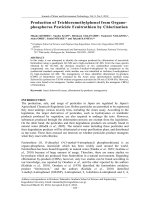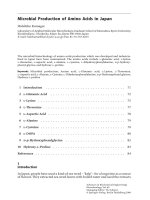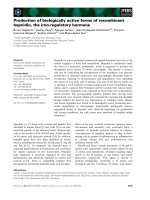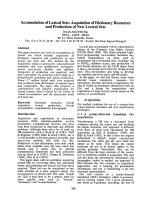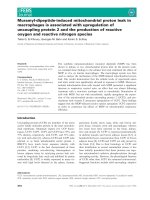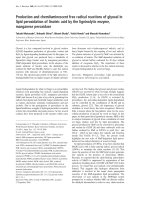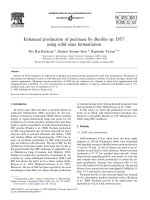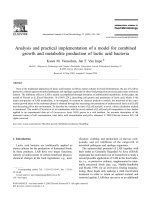Production of lactic acid by microbial fermentation of hemicellulose sugars
Bạn đang xem bản rút gọn của tài liệu. Xem và tải ngay bản đầy đủ của tài liệu tại đây (603.66 KB, 81 trang )
PRODUCTION OF LACTIC ACID BY MICROBIAL
FERMENTATION OF HEMICELLULOSE SUGARS
PUAH SZE MIN
NATIONAL UNIVERSITY OF SINGAPORE
2010
PRODUCTION OF LACTIC ACID BY MICROBIAL
FERMENTATION OF HEMICELLULOSE SUGARS
PUAH SZE MIN
(B.Sc. NUS)
A THESIS SUBMITED FOR
THE DEGREE OF MASTERS OF SCIENCE
DEPARTMENT OF CHEMISTRY
NATIONAL UNIVERSITY OF SINGAPORE
2010
ACKNOWLEDGEMENTS
It gives me great pleasure to express my deepest sense of esteem and my most
sincere gratitude to my NUS supervisor, Dr Huynh Han Vinh for his kind support and
invaluable guidance towards this work. I am truly thankful to him to accept me as his
part time student.
I will always be grateful to my research guide, Dr Wu Jin Chuan (A-STAR,
Institute of Chemical and Engineering Sciences ICES), who has encouraged me to
take up Masters course and his inspiration to me to do biological research even though
I have no background of it. His patient guidance, encouragement, sound advice and
support have made this thesis possible. I am also grateful to Dr Wong Pui Kwan
(A-STAR, Institute of Chemical and Engineering Sciences ICES), who has
encouraged me in many ways.
I would also like to thank my colleagues at ICES for their generous help,
especially Ms Ooi Kim Yng for her kind guidance, support and advice, Mr Lim Seng
Chong for providing excellent technical support for scanning electron microscopy
analysis and Mr Ritchie Chan for fabricating the novel fixed bed reactors. I am
thankful to my colleagues in Industrial Biotechnology laboratory. With that, I am
truly indebted to the Agency for Science Technology and Research (A*STAR
Singapore) for the financial support. Finally, I am utmost grateful to my parents for
their unconditional love, constant encouragement and motivation to their only child. It
is to them that I dedicate this work.
I
TABLE OF CONTENTS
ACKNOWLEDGEMENTS
I
TABLE OF CONTENTS
II
LIST OF TABLES
V
LIST OF FIGURES
VI
LIST OF SCHEME
IX
LIST OF ABBREVIATIONS
X
SUMMARY
XII
CHAPTER 1
1
INTRODUCTION
1
1.1. Prologue
1
1.2.
History of lactic acid
2
1.3.
Production of lactic acid
3
1.3.1.
3
Chemical synthesis
1.3.2.
Fermentation
4
1.3.3.
Lactic acid microorganisms
5
1.3.3.1
Lactic acid bacteria
7
1.3.4
Metabolic pathways of lactic acid bacteria
8
1.3.5
Pentoses fermentation
10
1.3.5.1
Utilization of xylose isomerase
13
1.4.
Cell immobilization
14
1.5.
Uses and Applications of lactic acid
16
1.6.
Scope of the thesis
19
II
CHAPTER 2
21
RESULTS AND DISCUSSION
21
2.1.
2.2.
2.3.
Fermentation of xylose, arabinose and glucose in 2 L fermenter
by Lactobacillus pentosus
21
2.1.1. Time courses of lactic acid production from glucose,
xylose and arabinose
21
Lactic acid fermentation using immobilized and free cells in
shake flasks
24
2.2.1.
29
Observation of morphologies of immobilized cells
Simultaneous xylose isomerisation and xylulose fermentation to
promote lactic acid production from xylose
31
2.3.1.
Effect of different quantity of xylose isomerase using
shake flask fermentation
32
2.3.2.
Effect of pH using shake flask fermentation
33
2.3.3.
Effect of temperature using shake flask fermentation
34
2.3.4.
Lactic acid production in 2 L fermenter
35
2.3.5.
Lactic acid production in novel bioreactors
41
CHAPTER 3
50
CONCLUSIONS
50
CHAPTER 4
52
EXPERIMENTAL PROCEDURES
52
4.1. Chemicals
52
4.2. Microorganism and cultivation broth
52
4.3. Immobilization of cells
53
4.4.
4.3.1. Modified MRS broth for fermentation using
immobilization cells
53
4.3.2.
Entrapment of cells in ordinary alginate beads
53
4.3.3.
Entrapment of cells in hybrid alginate-silica gel beads
54
Lactic acid fermentations
54
4.4.1. Fermentation conditions in 2 L fermenter
54
III
4.4.2. Fermentation with free cells in 2 L fermenter
54
4.4.3. Fermentation of immobilized cells in shaking flasks
55
4.4.4. Fermentation of immobilized xylose isomerase in shaking
flasks
55
4.4.5. Fermentation of immobilized xylose isomerase in 2 L
fermenter
55
4.4.6. Fermentation using novel fixed bed reactor in 2 L
fermenter
56
4.4.7. Recyclability of immobilized xylose isomerase in novel
fixed bed reactor
56
4.5. Observation of morphologies of immobilized cells
56
4.6. Sample preparations
57
4.7. Analytical methods
57
4.8. Calculation parameters
58
BIBILIOGRAPHY AND NOTES
59
IV
LIST OF TABLES
Table 1. Microorganisms used in the recent work of biotechnological
production of lactic acid.
6
Table 2. Recent investigation of xylose utilizing strains in the lactic acid
production.
11
Table 3. Comparison of lactic acid yields, final concentrations and
productivities between two fermentation systems, with and
without xylose isomerase dispersed in different initial xylose
concentrations.
37
Table 4. Comparison of lactic acid yields, final concentrations and
productivities between two SIF systems using novel reactor,
with and without xylose isomerase at different initial xylose
concentrations.
45
V
LIST OF FIGURES
Fig. 1.
Typical growth cycle of microorganisms in batch fermentation.
5
Fig. 2.
Formation of lactate from glucose by the homofermentation via
EMP pathway.7
8
Fig. 3.
Formation of acetate CO2, lactate
heterofermentation via PK pathway.6
9
Fig. 4.
Metabolic pathways of xylose fermentation to lactic acid
12
Fig. 5.
Xylose isomerase catalyzes D-glucose and D-xylose to
D-fructose and D-xylulose respectively.
13
Fig. 6.
A simplified flowchart of the potential products and technology.
17
Fig. 7A.
Time courses of lactic acid fermentation using glucose as the
carbon source.
23
Fig. 7B.
Time courses of lactic acid fermentation using xylose as the
carbon source.
23
Fig. 7C.
Time courses of lactic acid fermentation using arabinose as the
carbon source.
24
Fig. 8.
Photos of the beads before and after fermentation.
25
Fig. 9A.
Production of lactic acid at 20 g/L xylose concentration with
free cells.
27
Fig. 9B.
Production of lactic acid at 20 g/L xylose concentration with
ordinary alginate beads.
27
Fig. 9C.
Production of lactic acid at 20 g/L xylose concentration with
hybrid alginate-silica beads.
28
Fig. 10.
Time courses of cell density of the fermentation broths using
free cells and cells immobilized in ordinary alginate and hybrid
alginate-silica beads.
28
Fig. 11.
SEM micrographs of ordinary alginate and hybrid alginate-silica
beads after shake flask fermentation.
30
Fig. 12.
Effect of quantity of immobilized xylose isomerase in the lactic
acid production.
33
Fig. 13.
Effect of different pH range in the lactic acid production.
34
Fig. 14.
Effect of different temperature range in the lactic acid
production.
35
and
ethanol
from
VI
Fig. 15A.
Time courses of simultaneous in-vitro xylose isomerisation and
fermentation to lactic acid by L. pentosus at 20 g/L xylose
without xylose isomerase.
38
Fig. 15B.
Time courses of simultaneous in-vitro xylose isomerisation and
fermentation to lactic acid by L. pentosus at 20 g/L xylose with
8g of xylose isomerase.
39
Fig. 15C.
Time courses of simultaneous in-vitro xylose isomerisation and
fermentation to lactic acid by L. pentosus at 50 g/L xylose
without xylose isomerase.
39
Fig. 15D.
Time courses of simultaneous in-vitro xylose isomerisation and
fermentation to lactic acid L. pentosus at 50 g/L xylose with 8g
of xylose isomerase.
40
Fig. 15E.
Time courses of simultaneous in-vitro xylose isomerisation and
fermentation to lactic acid by L. pentosus at 100 g/L xylose
without of xylose isomerase.
40
Fig. 15F.
Time courses of simultaneous in-vitro xylose isomerisation and
fermentation to lactic acid by L. pentosus at 100 g/L xylose with
8g of xylose isomerase.
41
Fig. 16.
Photos of the fermenter with xylose isomerase directly dispersed
in the broth
42
Fig. 17.
Schematic diagram of a novel bioreactor for simultaneous
xylose isomerisation and fermentation (SIF).
42
Fig. 18.
Photos of the constructed small fixed bed reactors and their
installation in the fermenter.
43
Fig. 19.
Photos of the fixed bed reactor, packing of immobilized
biocatalyst and installation of the reactor inside the fermenter.
44
Fig. 20A.
Time course of simultaneous xylose isomerase and fermentation
to lactic acid by L. pentosus in the novel bioreactor without
xylose isomerase. Initial xylose concentration was 20g/L.
45
Fig. 20B.
Time course of simultaneous xylose isomerase and fermentation
to lactic acid by L. pentosus in the novel bioreactor with 65 g of
xylose isomerase. The initial xylose concentration was 20g/L.
46
Fig. 21A.
Time course of simultaneous xylose isomerase and fermentation
to lactic acid by L. pentosus in the novel bioreactor without
xylose isomerase. The initial xylose concentration was 50g/L.
47
Fig. 21B.
Time course of simultaneous xylose isomerase and fermentation
to lactic acid by L. pentosus in the novel bioreactor with 65 g of
immobilized xylose isomerase. The initial xylose concentration
was 50g/L.
48
VII
Fig. 22.
49
Lactic acid productivity and yield of the repeated simultaneous
xylose isomerisation and fermentation by L. pentosus in the
novel bioreactor with 65 g of immobilized xylose isomerase
packed in a stainless fixed bed reactor with a permeable wall.
VIII
LIST OF SCHEME
Scheme 1.
Chemical synthesis of lactic acid. (a) Addition of hydrogen
cyanide (b) Hydrolysis by sulfuric acid (c) Esterification (d)
Hydrolysis by water.
4
IX
LIST OF ABBREVIATIONS
ADP
ATCC
ATP
BP
Adenosine diphosphate
American Type Culture Collection
Adenosine-5-triphosphate
Bisphosphate
CaCl2
Calcium chloride
CECT
Spanish Collection of Type Cultures
CO2
Carbon dioxide
EMP
Embden-Meyerhof-Parnas
Ent
FDA
GRAS
h
H2SO4
HCl
HPLC
Enterococcus
Food and Drug Administration
Generally recognized as safe
hour(s)
Sulfuric acid
Hydrogen chloride
High Performance Liquid Chromatography
L
Litre
L
Lactobacillus
LAB
Lc
LDH
Lactic acid bacteria
Lactococcus
Lactate dehydrogenase
X
Leu
MRS
Leuconostoc
de Man, Rogosa and Sharpe
NADH
Nicotinamide adenine dinucleotide hydride
NaOH
Sodium hydroxide
OD
P
PDLA
PDLLA
Optical density
Phosphate
Poly (Dextro-lactic acid)
poly (Dextro, Levo-lactic acid)
Ped
Pediococcus
PK
Phosphoketolase
PLA
PLLA
Polylactic acid
Poly (Levo-lactic acid)
PP
Pentose phosphate
R
Rhizopus
SEM
Scanning electron microscopy
SIF
Simultaneous xylose Isomerization and Fermentation
Str
Streptococcus
TMOS
Tetramethoxysilane
XI
SUMMARY
Lactic acid has wide applications in food, feed, cosmetics and textile industries
as well as in producing polylactic acid (PLA), a very promising biodegradable
polymer. Lactic acid is commercially produced by microbial fermentation using
starchy crops such as corn and cassava as the feedstock. To reduce the cost of
feedstock and avoid competition with foods, the use of cheap, abundant and
renewable lignocellulose as an alternative feedstock has received much attention in
recent years. Lignocellulose is composed of cellulose (30-50%), hemicellulose
(20-40%) and lignin (10-30%). In theory, all the lignocellulose sugars can be utilized
as carbon sources for microbial fermentation, but xylose, the major component of
hemicellulose sugars, cannot be efficiently metabolized by most lactic acid bacteria
including Lactobacillus, which are extensively used in industry for starch-based lactic
acid production
In this thesis, we investigated the feasibility of improving lactic acid production
from pentoses by using L. pentosus, a commercially available lactic acid bacterium
which is able to utilize xylose as the carbon source. L. pentosus was chosen as the
model microorganism in our study because it has the ability of converting the
non-conventional sugars such as xylose and arabinose into lactic acid and it has also
widely utilized by researchers. Batch fermentations in 2 L fermenter using different
carbon sources (glucose, xylose and arabinose) were conducted to determine the time
courses of lactic acid production and cell growth of L. pentosus. It has been shown
XII
that L. pentosus ferments glucose by the homofermentative Embden-Meyerhof-Parnas
(EMP) pathway giving lactic acid as the sole product, but it metabolizes xylose and
arabinose by the heterofermentative phosphoketolase (PK) pathway, producing
equimolar amount of lactic acid and acetic acid. At a sugar concentration of 20 g/L in
MRS broth (according to De Man, Rogosa and Sharpe), the lactic acid productivity
was 0.50 g/L·h from glucose and 0.32 g/L·h from xylose, and L. pentosus was unable
to consume all the arabinose. For the fermentation using mixed sugars, glucose was
first consumed by L. pentosus prior to xylose and arabinose. A shift in metabolic
pathway from EMP to PK occurred accompanying the complete consumption of
glucose and generation of acetic acid.
Immobilization of L. pentosus into calcium alginate beads was performed to
increase cell density and reusability. To improve the rigidity of the ordinary calcium
alginate beads, alginate-silica hybrid beads were prepared by dissolving
tetramethoxysilane (TMOS) into the alginate solution during the bead preparation. It
had been found that the L. pentosus cells entrapped in the alginate-silica beads gave
almost the same lactic acid yield with those entrapped in the ordinary alginate beads,
although the rigidity and cell leakage were slightly improved by using the hybrid
beads compared to the ordinary alginate beads. It was also observed that no
significant improvement in lactic acid yield was achieved in the cases of entrapping
the cells in the beads compared to the case of free cells.
As xylose isomerisation to xylulose is the first step of xylose utilization by the
lactic acid bacteria, commercial immobilized xylose isomerase was employed to
XIII
promote the utilization of xylose by the L. pentosus. Batch fermentations in 2 L
fermenter were performed at different initial xylose concentrations in MRS broths. A
fixed bed reactor with permeable wall was designed, constructed and installed inside
the 2 L fermenter. The immobilized xylose isomerase was packed inside the fixed bed
reactor which was rotated together with the mechanical steer of the fermenter. At a
xylose concentration of 20 g/L, xylose was completely consumed within 24 h in the
novel bioreactor with immobilized xylose isomerase, but it took 72 h in the case
without using the xylose isomerase (control). Similarly, the cells grew much quicker
and better in the novel bioreactor than in the control. The lactic acid productivity in
the novel bioreactor was 3.8 times higher than that of the control, and the lactic acid
yield in the novel bioreactor was 1.3 times higher than that of the control and was also
higher than the theoretical value based on the phosphoketolase pathway. The final
lactic acid concentration of the novel bioreactor was 1.3 times higher than that of the
control. When the initial xylose concentration was increased to 50 g/L, the xylose was
completely consumed within 55 h in the case of the novel bioreactor, but there was
still 15 % of the initial xylose unutilized in the control. The lactic acid productivity
and yield were 2.9 and 1.2 times higher than those of the control.
The recyclability of the immobilized xylose isomerase was tested. It had been
found that the activity of xylose isomerase dropped obviously after the first use of the
enzyme, but remained almost unchanged afterwards. We were able to reuse the
enzymes for 5 more cycles without obvious reduction of lactic acid yield and
productivity.
XIV
This novel bioreactor constructed here can also be utilized for other xylose
fermentation processes such as xylose fermentation to ethanol by Saccharomyces
cerevisiae.
XV
CHAPTER 1
INTRODUCTION
1.1.
Prologue
Lactic acid is widely utilized in food, cosmetics and pharmaceutical industries.1
In recent years, its demand has been increasing owing to its use as a monomer for the
production of polylactic acid (PLA), a biodegradable polymer, as an environmentally
friendly alternative to plastics derived from petrochemicals.2 Lactic acid can be
commercially produced either from petroleum by chemical synthesis or from
renewable resources by microbial fermentation.2,3 The chemical synthesis routes
produce only racemic lactic acid while optically pure L(+)- or D(-)- or racemic lactic
acid can be produced by fermentation using specific microbial strains.4 Thus,
production of lactic acid by fermentation has gained much attention due to the
environmental concern and gradual depletion of petrochemical resources.2 It is
estimated that over 90 % of the commercial lactic acid is produced by microbial
fermentation.5
Starchy materials are the primary carbon sources for the commercial production
of lactic acid.6 Lignocellulose, however, has received much attention as an alternative
for lactic acid production due to its rich availability and no conflict with food supply.
Lignocellulose, primarily composed of cellulose, hemicellulose and lignin, cannot be
directly utilized as a carbon source and needs to undergo pretreatment and hydrolysis
1
steps to yield fermentable sugars suitable for microbial fermentation. Hydrolysis of
cellulose releases only glucose as the sole monomer, but the hydrolysis of
hemicellulose gives a mixture of pentoses (D-xylose, L-arabinose) and hexoses
(D-glucose, D-galactose, D-Mannose) with D-xylose being the major component
(around 80 %).7
1.2.
History of lactic acid
The discovery of lactic acid as a chemical substance was the achievement of the
chemist named Carl Wilhelm Scheele in 1780. Scheele isolated an acid from sour milk
samples and initially considered it a milk component. He named the new acid after its
origin Mjölksyra which means acid of milk.8
The first quantitative elementary analysis of lactic acid was reported in 1833 by
Gay-Lussac and Pelouze who made the conclusion that the formula of lactic acid was
C6H12O6 based on the copper oxide method. This is the formula of the dimer; the
lactic acid today is presented by the formula C3H6O3.9
The era of fermentation technology began in the 18th century, when the study of
lactic acid by Gay-Lussac, Fremy and F.Boutron in 1839 led to the finding of lactic
acid as a fermentation product from sugar, vegetable and meat products. In 1857,
Pasteur discovered a special ferment, a lactic yeast that was found when sugar was
transformed into lactic acid and that it was not a milk component as mentioned by
Scheele. Pasteur remarked that the origin of the lactic yeast present in the experiments
could have been the atmospheric air and this led to the emerging science of
2
microbiology.10 The making pure culture of bacterium lactis by Joseph Lister11 in
1860 had led to the naming of the lactic acid bacteria as Bacillus Delbrücki
(systematic name Lactobacillus delbrueckii).12 The first commercial lactic acid
production of an industrial chemical by fermentation process took place in the United
States of America.13
1.3.
Production of lactic acid
1.3.1.
Chemical synthesis
The chemical synthesis routes gave racemic lactic acid. The commercial process
for chemical synthesis is based on lactonitrile, which is a by-product from
acrylonitrile synthesis (Scheme 1). It involves addition of hydrogen cyanide in
presence of a base to acetaldehyde to produce lactonitrile which occurs at atmospheric
pressure (a). The crude lactonitrile is recovered and purified by distillation. It is
hydrolyzed to lactic acid by using either concentrated hydrochloric acid or sulfuric
acid to produce ammonium salt and lactic acid (b). The lactic acid is then esterified
with methanol to produce methyl lactate which is removed and purified by distillation
(c). The methyl lactate is furthered hydrolyzed by water under acid catalyst to produce
lactic acid and methanol, which is recycled (d).4,14
3
Scheme 1. Chemical synthesis of lactic acid. (a) Addition of hydrogen cyanide (b) Hydrolysis by
sulfuric acid (c) Esterification (d) Hydrolysis by water
1.3.2.
Fermentation
Fermentation processes are characterized by biological degradation of substrate
(carbohydrate like glucose) by a population of micro-organisms into metabolites such
as ethanol, citric acid and lactic acid.15 The desired stereoisomer of lactic acid can be
produced by using a specific lactic acid bacteria. During fermentation, calcium
hydroxide or sodium hydroxide is used to neutralize the acid produced and a calcium
or sodium salt of the acid in the broth is produced. After removing the cell biomass,
the filtrate which consists of calcium or sodium lactate is carbon treated. The filtrate
is evaporated and acidified with sulfuric acid to yield lactic acid and the insoluble
calcium or sodium sulphate which is removed by filtration.4
In the fermentation, a growth cycle is observed which is differentiated in 4
different phases (Fig.1). In the lag phase, the organism is adapting to the new
environment such as competing for the carbon source, and the net outcome is a cell
that is capable of transforming chemicals to biomass. In the exponential (acceleration)
phase, the cells multiply and are capable of transforming the primary carbon source
4
into biosynthetic precursors which are channeled through various biosynthetic
pathways for the biosynthesis of various monomers. After the exponential phase, the
cells enter the stationary phase and eventually to death phase where there is limitation
of nutrients for the cell growth.16
Stationary
phase
Exponential
phase
Death
phase
Ln
Biomass
Lag
phase
Time
Fig. 1.
Typical growth cycle of microorganisms in batch fermentation.
1.3.3.
Lactic acid microorganisms
Bacteria and fungi are the two groups of microorganisms that can produce lactic
acid.17 While most of the lactic acid production are carried out by lactic acid bacteria
(LAB), filamentious fungi such as Rhizopus also utilize glucose aerobically to
produce lactic acid.18 Rhizopus species such as R. oryzae and R. arrhizus have
amololytic enzyme activity which enable them to convert starch directly to L(+) lactic
acid.19 Several authors have reported fungal fermentations. Park et al.20 produced
lactic acid from waste paper using R. oryzae. Huang et al.21 produced lactic acid from
potato starch wastewater using R. oryzae and R. arrhizus. Tay and Yang et al.22
5
produced lactic acid from glucose and starch using immobilized R. oryzae cells in a
fibrous bed. Kosakai et al.23 cultured R. oryzae cells with the use of mycelial flocs
formed by the addition of mineral support and polyethylene oxide. Although there
have attempts made to produce lactic acid through fungal fermentation, LAB have
been commonly used due to disadvantages of fungal fermentation like low production
rate and low product yield.20,22 The microorganisms used in the recent work of the
biotechnological production of lactic acid are listed in Table 1.
Table 1. Microorganisms used in the recent work of biotechnological production of lactic acid.
Microorganisms
Rhizopus Oryzae NRRL 395
Rhizopus Oryzae ATCC
52311
Lactobacillus delbrueckii
NCIMB8130
Lactobacillus lactis
Lactobacillus amylophilus
GV6
Lactobacillus plantarum
ATCC 21028
Lactobacillus casei NRRL
B-441
Lactobacillus rhammosus
ATCC10863
Lactobacillus salivarius sp.
Salivarius ATCC 11742
Lactic acid
γ(g/L)
104.6
Yield
Y (g/g)
0.9
Productivity
Reference
P (g/L·h)
1.8
20
83.0
0.9
2.6
18
90.0
1.0
0.4
24
109.0
0.9
1.1
25
76.2
0.7
0.8
26
41.0
1.0
1.0
27
82.0
0.9
5.6
28
67.0
0.8
2.5
29
28.0
0.9
11.0
30
6
1.3.3.1.
Lactic acid bacteria
Lactic acid bacteria (LAB) are a group of related bacteria that produce lactic
acid as major product.31 LAB have the property of producing lactic acid from
carbohydrates through fermentation.31 LAB consist of bacterial genera within the
phylum Firmicutes comprised of about 20 genera, and they are of the Gram-positive
genera: Carnobacterium, Enterococcus (Ent), Lactobacillus (L), Lactococcus (Lc),
Leuconostoc (Leu), Oenococcus, Aerococcus, Pediococcus (Ped), Streptococcus (Str),
Tetragenococcus, Vagococcus, and Weissella.31,32,33 Lactobacillus is the largest of
these genera, comprising around 80 recognized species.31,33
Lactobacilli vary in morphology from long, slender rods to short coccobacilli
which frequently form chains.33 Most LAB are facultatively anaerobic, catalase
negative, nonmotile and nonspore forming and they produce lactic acid as the major
end product during sugar fermentation.31 LAB can grow at temperatures from 5 oC to
45 oC and are tolerant to acidic conditions, with most strains able to grow at pH 4.4
(the optimum pH is 5.5-6.5).33
LAB have complex nutritional requirements due to their limited ability to
synthesize their growth factors such as B vitamins and amino acids.7,19 Therefore,
they require some elements for growth such as carbon and nitrogen sources in the
form of carbohydrates, amino acids, vitamins and minerals.7 A typical media for the
LAB growth is MRS broth (according to De Man, Rogosa and Sharpe) which is used
for the enrichment, cultivation and isolation of all lactobacillus species.34
7
1.3.4.
Metabolic pathways of lactic acid bacteria
Lactic acid bacteria ferment sugars via different pathways resulting in homo- and
hetero-fermentation.7 Most LAB are strictly fermentative but are aerotolerant. Some
streptococci, however, can use oxygen as H-acceptor and even form cytochromes
under certain conditions.35
In homo-fermentation, LAB convert glucose almost exclusively into lactic acid
via the Embden-Meyerhof-Parnas (EMP) pathway (i.e. glycolysis).35 EMP is the
pathway where the glucose degrades into pyruvate.35 Since lactic acid is the major
end-product of glucose metabolism, two lactic acid molecules are produced from each
molecule of glucose 36 : Glucose
2 lactate (Fig. 2)
Glucose
1 ATP
Fructose 6-P
1 ATP
Fructose 1,6-BP
Glyceraldehyde-3-P
Dihydroxyacetone-P
4 ATP
2 NADH
2 Pyruvate
LDH
2 NADH
2 Lactate
Fig. 2.
Formation of lactate from glucose by the homofermentation via EMP pathway.7
8
